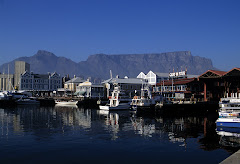Our afternoon began with a bus tour of the island, which explained that it began as a Leper colony from 1836 to 1931. It was then vacant until 1939, when it served as a military site during the Second World War. However, by 1959, Robben Island changed hands and became the maximum security prison for which it is widely known.
I was overwhelmed walking through the Robben Island prison, where Nelson Mandela was imprisoned for 18 of his 27 years before being released during the breakdown of Apartheid. It was definitely a surreal experience to see Mandela's jail cell and have a tour guide who also had been a prisoner after being arrested and tortured for fighting to end Apartheid. Our guide had been arrested after partaking in some civil unrest, and was found guilty of illegally leaving and then re-entering the country without the proper permission of the White Apartheid government (which wouldn't have been granted anyways).
It is quite an atmosphere to take in, especially when trying to picture the cells, overcrowded with inmates and prison guards roaming the halls.
Take-home Message: One of the most touching parts of the tour was from our first guide on the bus. Before we exited, he asked each of the people on our bus what country they are from. He concluded by saying, "if the whole world can fit and get along on this bus, please go out there and do the same." He went on to ask us to make sure that what happened in South Africa does not happen again, and that it is our responsibility to make changes in the inequalities in the world.





No comments:
Post a Comment